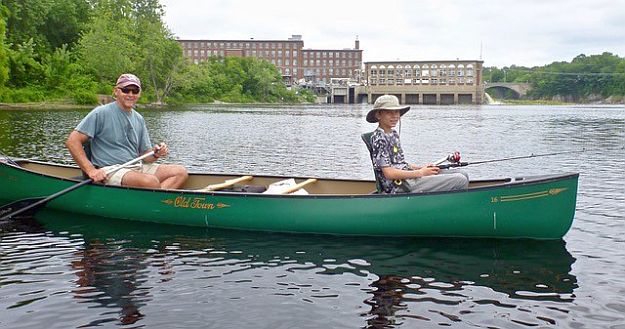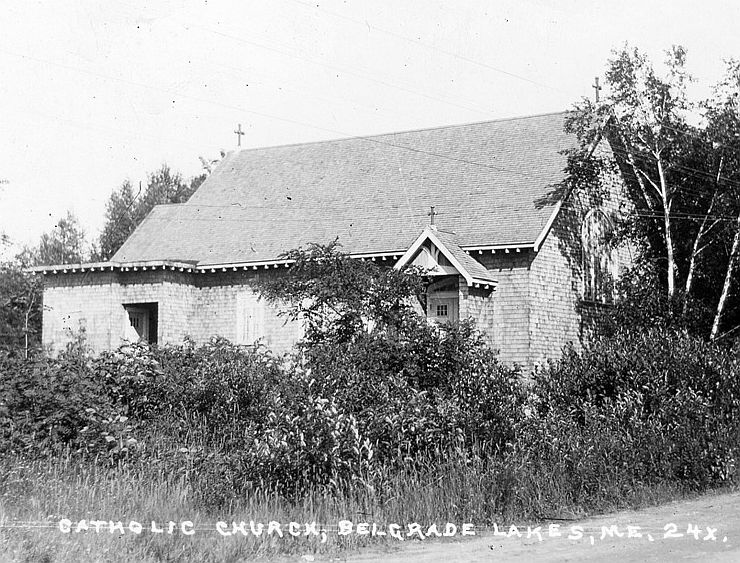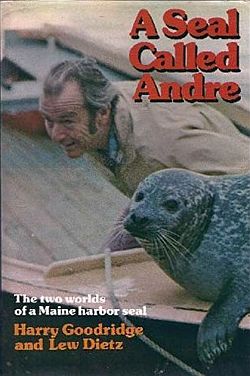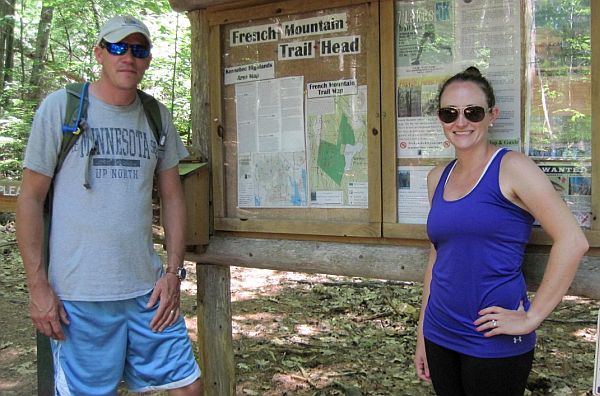
Lynn Matson and grandson Alex canoe the Kennebec River in Waterville. The former Hathaway Mill is in the background, on the right. More…
Highlights from this issue…
- Farewell to MIFF: A Look Back And A Look Ahead
- A Village Stroll in 1959, Part II
- André, The Famous Harbor Seal
- Counting Loons
Download Full Print Edition [PDF] • Links to Other Pages on This Site
These archival articles are presented “as is.” Except for minor corrections or clarifications, most have not been updated since they appeared in print. Thus, some details may be out of date, and some hyperlinks may no longer work.
Farewell to MIFF: A Look Back And A Look Ahead

Emma Thompson portrays family court judge Fiona Maye in The Children Act, winner of this year's Audience Favorite Award. The film is expected to return to Railroad Square Cinema for a weeklong run this fall.
The twenty-first annual Maine International Film Festival has ended. The projectors have been shut off; the screens have gone dark; and the theaters are empty, save perhaps for a few discarded bubble gum wrappers and half-filled bags of popcorn. Ah, but the memories linger.
Looking back at this year's MIFF, here are a few of the highlights:
- Watching the luminous Dominique Sanda in the 1971 classic, The Garden of the Finzi-Continis, and then seeing her in person as she accepted MIFF's 2018 Lifetime Achievement Award
- Viewing the festival's oldest movie, 1927 silent romance 7th Heaven, with a brand new, jazz score performed live — its world premiere — with its composer, midcoast Maine trumpeter Mark Tipton and his quartet, Les Sorciers Perdus.
- Seeing two films that are even more timely than when late director Hal Ashby made them in the 1970s: Bound for Glory, about the early, "hard travelin'" days of Woody Guthrie in during the Great Depression; and Being There, about an illiterate gardener whose knowledge of the world comes solely from watching television, whose pronouncements about gardening are mistaken for wise metaphor, and who, by chance, becomes confidant to a wealthy, but ailing, businessman and political kingmaker.
- Strolling through an animated, 3D forest and interacting with its inhabitants at the MIFFONEDGE exhibit at Common Street Arts — a trip that before the invention of virtual reality headsets would only have been possible with the use of psychedelic drugs.
- Enjoying the innovative work of the three Latin American filmmakers who comprised this year's World Filmmakers' Forum, including the film Good Manners, the title which gives no clue as to its content as the weirdest, and probably the only, Brazilian, lesbian, werewolf, horror musical ever to be shown at MIFF — and which was the runner up for this year's Audience Favorite Award.
At the festival's closing ceremony at 7:00 at the Waterville Opera House, festival organizers announced The Children Act as the winner of this year's Audience Favorite Award. In the film, Emma Thompson portrays a British family court judge, who always takes her cases personally and who decide whether a 17-year-old Jehovah's Witness may reject a blood transfusion that will save his life but contravene his faith.
Any audience member who has seen at least three new movies may vote for his or her favorite by submitting a paper ballot. (A "new" movie is a recently completed film that has not yet been commercially released in the United States, although it may have been released in another country or been shown at other film festivals in the U.S.) The movie with the most votes wins, and the winner is always announced just prior to the screening of the festival's final film, which this year was Support the Girls, a workplace drama/comedy set in a Hooters-like sports bar.
Looking ahead, MIFF may have a new home two or three years from now. Colby College and Waterville Creates! are hoping to renovate The Center, i.e. the building at the corner of Main Street and Castonguay Square in downtown Waterville, into a new arts center, which will include a three-screen cinema.
Long the home of the Stern's Department Store, the building has, for the past quarter century, housed various businesses, nonprofit institutions, and governmental offices, including, most notably, the Common Street Arts gallery, classroom, and clay studio; the Waterville Opera House's dance studio and studio theater; Waterville's city council chambers; and, until a few months ago, the Maine Made Shop.
In its new incarnation, the building will continue to house the Common Street Arts gallery, classroom, and clay studio, but also a modern art gallery for the Colby Museum of Art, rehearsal space for the Waterville Opera House, a new media and film-editing classroom, and the three movie theaters to replace the ones at Railroad Square Cinema. The renovation will include removing the building's fourth floor and part of the southern brick wall along Castonguay Square. The latter will be replaced by wall of glass that will extend all the way to Waterville City Hall. The space between The Center and City Hall will be enclosed in a two-story, glass atrium.
The project is expected to cost $18 to $20 million, $8 million of which had been raised before the project was publicly announced in early March. There is no set time frame for completion. Construction will not begin until fundraising is nearly complete, but is expected to take about 18 months. For artist's renderings and addtional information about the project, visit www.downtownartscenter.org.
Print Article • Go to Top of Page
A Village Stroll in 1959, Part II

St. Helena's Catholic Church, ca. 1920.
In Part One of "A Village Stroll," we left the home of Lydia and Albert Johnson (now Hello Good Pie and 39 Main Street) and shuffled our way northerly. Remember, this is 1959.
After going only 20 steps or so, we see the large, brown Catholic church. It has been a landmark since long before I was a wee kid running up and down these streets. History has it that the McCormack-Alter family from New York City purchased the land and arranged to have the church built in 1913. Prior to that many summer residents attended church services provided in the McCormack Camp and others, as well as in the Belgrade Hotel.
The church is very much of a seasonal building and is open during the warm months when many Catholic tourists are in residence at cottages. Saturday evenings and Sunday mornings, cars are lined up on both sides of the road. It appears very well kept, with stained glass windows and rustic open beams and boarding inside. We shuffle away from the big brown church, continue northerly and cross the end of school street. The Church operates today, still in a seasonal status.
Another twenty feet or so and we stop in front of a large looming building with an old glass bulbous sign hanging off a rusty bracket. The building sits very close to the road. The faded lettering on the round glass says "Legion Hall."
The building appears in major disrepair with scaly dull-white paint over its clapboard siding and is clearly "leaning towards Sawyers." Not much happens here anymore, though a dwindling American Legion group still has an occasional meeting here. The building gets used lightly by other groups such as the Ladies Aid, a group of card players, maybe a local primary school play as a small stage is present.
Since 1959 the building has gone through some major changes. We now know that this was the first school in Belgrade Lakes, circa 1887 to 1929. A new school building replaced this one just behind it on school street in 1929, when classes and the bell were moved the 100 yards to the East. The Legion bought the building from the Town at that time. Both WWI and WWII spawned many post war groups that bought or built their own buildings during that era.
In the 1980's, a young couple named Martin and Nancy Dionne bought the building from the Legion and did a major renovation. The building was given a complete foundation, all new mechanicals, insulation and trim. The Dionnes used the building for a home on the second floor and a dance studio on the first floor, where Nancy taught dance and yoga. After several years the building was sold to Marcell Schnee and the usage changed from home and dance studio to a physical therapy facility, apartment above and print shop in the newer basement. This arrangement continues today.
Let us march forth another 20 yards or so until we are directly opposite the flower garden at the intersection of West Road and Route 27, still on the East side of the road.
A nearly new small home has recently been built. The owners are Charles and Shirley Blood. Shirley, daughter of Sadie Yeaton, waves a hello as she works in the small flower bed along the front of the house. Charlie is in the lumber and land business. The home was later sold to Bob and Bonnie Teague who brought up their two sons there. Several other owners have occupied the home since, but the appearance has changed little other than cosmetics.
As we continue northerly down the street, our next stop will be a large brown colored home with a hip roof and several shed dormers. It has long been the home of Chester Thwing, owner and builder of Woodland Camps. I personally know him as the old man who has a Stanley Steamer in the garage. Each summer he fires up the boiler and takes all us town kids for a joy ride. (For more on that see my story in The Luckiest Boy, Season II.)
Chester died soon thereafter, Clayton and Betty Grant became the next dwellers to occupy the house. As an aside, Clayton and Betty later bought Woodland Camps from Donald Mosher, Chester's son in law. Clayton died in 1983 and Woodland was sold in 1988/89.
Immediately, we realize that Chester's driveway is really what separates his property and that of the Union Church. The Church, like the Catholic Church, is a seasonal building, meaning there is no significant heating system other than a woodstove that is seldom used, and a minimal or nonexistent water system. My memories include: begrudgingly going to Sunday School there in the past summers, my grandfather's funeral in the early 1950's and probably a wedding or two. The church was later added onto and the adjoining property of Dawson Wyman on School Street was purchased for a parking lot. The Church seems well attended and supported today, and has been modernized to become a year-round Church.
Let's go at least one more home today. Just shuffle along everyone. Only 30 more feet and whoa. We have arrived at the home of Ken and Katherine Bartlett. For several decades they owned and operated the local general store downtown, but 3 years ago sold it to a New Sharon couple named James and Mae Day, along with their 2 sons, Gary and Darryl.
Ken has also acted as the local real estate agent and has been in a partnership with General Edmond Hill over the last decade or so, probably since the end of WWII. They seemed to have developed some land on Long Pond and sold some camp lots in several areas.
Years after we stop by, they sell the home to Darryl and Linda Day about 1970. The Days live in this house for perhaps a decade. The Bartletts have built a campground where the Community Center is now, and have run that for several summers. They build a retirement house on top of Smith Hill where they live the rest of their years. The Smith Hill house is now the club house for the Belgrade Golf Course.
We are out of space for today, so hold tight, come back a week from now and we will try to pick it up where we left off. What's Next? Hint: the old P.O.
Start the Stroll • Continue the Stroll
Print Article • Go to Top of Page
André, The Famous Harbor Seal

My daughter Toni had come down to the waterfront with me one afternoon, wearing a new coat decorated with brass buttons. She reached down to pat Andre's head. Feeling playful, or perhaps puckish, he arched up, nipped one of the buttons from her coat, and dropped it into twenty feet of water…Toni was distressed, of course. I was quite angry and gave him a real dressing-down. Then I forgot about it…The next day I went down to the waterfront. Andre was waiting. He dropped the button at my feet.
In June this summer, our local paper reported that the Rockport statue of Andre needed repair. A crack had appeared in the head. Twelve thousand dollars was being raised and repairs began immediately. Gray granite stone forms the lifelike body of Andre who migrated from the island of his birth to Rockport to live with his friend Harry Goodridge from 1961 until 1986.
I am reading both books about Andre. It is a pleasure rereading André, The Famous Harbor Seal, a picture book that was so well loved and worn out that it had to be discarded from our local public library. Fran Hodgkins wrote that children's classic, illustrated by Yetti Frenkel, in 2003. A Seal Called Andre by Harry Goodridge and Lew Dietz, 2014, was still on the juvenile shelf for me, thanks to Jarod, library assistant, who found it! [Martha Barkley is referring to the paperback edition; the book was originally published in hardcover in 1975.]
Both books have special pages showing Andre with the Goodridge family cat in their Rockport kitchen. All you pet lovers, whether it is cats or dogs, will find Andre friendly to every creature great and small, even chickens. Lobster traps at the harbor have Andre napping on them on the dock. It has been a heart-warming experience to compare the photos of Andre's many antics in one book with the beautiful illustrations in the award winning children's picture book. The friendship between Andre and Harry Goodridge, WWII veteran, is portrayed lovingly.
Andre was a captured wild animal who had the choice of remaining wild or living in captivity. For twenty-five years he chose both. The simple explanation for this could be that Andre had "imprinted" on Harry or was just taking advantage of free room and board. The deeper explanation involves qualities of intelligence and sensitivity in both seal and man that have not been measured and may never be.

Some of you may have seen Andre's Rockport harbor performances during the summer tourist season. His popularity has been compared to coastal artist Andrew Wyeth…Andre and Andy Wyeth, what Maine tourist attractions. Of course, we have our local lake loons calling everyday and the occasional moose in the woods. Many many good books on loons and moose. Go find them…Jarod or Brian or Janet, director, will help you at our Belgrade public library.
Marblehead, the Mystic and Boston Aquariums all played a part in Andre's winter locales. Each spring, he was left out to sea and some days he swam one hundred miles towards his summer home. Can you imagine that? The great migratory swims of Andre were studied by many up and down the coast. Occasionally, he was given a car ride and eventually a flight as he aged, in order to winter comfortably south of Rockport.
Such a story of wild animal and man sensitive to nature. Their friendship made headlines every summer and the Goodridge family welcomed their special visitor as a member of the family inside their home. Four years after Andre died and was buried by Harry in a pet cemetery, Harry died. His children spread Harry's ashes out at Robinson's Rock where Andre was born. Two lobster boats took the sixteen family members out on a cloudless July day: "In the silence that followed the cutting of the engines, we were surrounded by dozens of curious seals, who watched as we scattered Harry's ashes, along with lilies and forget-menots, over the glistening water. The seal and his man had come full circle — the ending back at the beginning."
Written by Harry's daughters: Susan, Carol, Paula and Toni (who had Andre at her wedding in person!) Photo on page 190, if you want to see it…
Print Article • Go to Top of Page
Counting Loons

Trolling through the "fog of war" at 6:40 a.m. Photo by Fred Knight.
The third Saturday in July was the annual loon count in Maine, coordinated by Maine Audubon. Every year over 1000 volunteers, of which I am one, attempt to count all the loons on a couple hundred Maine lakes at the same time.
It's organized like a military operation and I am the coordinator for the dozen or so volunteers on Long Pond. Early in the morning all counters head for their assigned section of the lake to be in position to count all the adult loons and loon chicks in their area between 7:00 a.m. and 7:30 a.m.
I left my dock around 6 a.m., planning to fish for a bit before picking up my assistant counter, Fred Knight, at the Village Inn docks at 6:45. I was grateful for the blue skies and light winds compared to last year's cold and rain but as I cleared my cove, I realized there was a solid fog bank beginning about half way down the lake. It looked like it was burning off fairly rapidly but visibility was going to be reduced so we would have to search slower than usual with closer spacing on our tracks.
Our assigned sector was Lynch Cove, one of the smaller sectors, so I wasn't worried. I thought about Carl von Clausewitz's "fog of war" and how it affected even small operations like ours. I began trolling slowly through the fog toward the dock when I spotted Fred heading down to the dock. I picked him up and we headed into our sector, looking for loons. We spotted one loon surfacing in the fog behind the boat just as we entered our area.
Suddenly, my phone rang. It was one of my other counters who was having engine trouble on his boat, wanting to know if we could count his sector as well. His sector was adjacent to ours and visibility was beginning to improve so we sped up a bit and continued our search.
I also realized why modern soldiers loosely translate the "fog of war" as "s**t happens." We managed to get through both sectors by about 7:35 ending with a pair of loons feeding their two chicks in a secluded cove on the western shore of Long Pond, always an awesome sight that fills me with joy.
There were lots of kids and grandkids on the lake this week, although none of them mine. I did get to see my grandson play his saxophone in a jazz concert in Farmington, where he attended a jazz camp last week.
I saw lots of other young faces around, though. Several of my friends had their grandkids visiting. Both Dick Greenan and Lynn Matson had grandkids staying with them so they launched a grandpa/grandkid canoe trip down the Kennebec River, which was interrupted by a thunderstorm. They came off the water and headed for ice cream, batting cages, and disc golf. Lots of memories being made in the process. Lynn also spent some time on the lake with Alex teaching him to use Lynn's standup pedal board and later enjoyed the fruits of his labors.

Jason and Amanda at the French Mountain trailhead.
I also got a little hiking in and some foraging for raspberries and mushrooms. At French Mountain I ran into Jason and Amanda, a young couple from Princeton, NJ. When I asked what brought them to our area, Amanda explained that her grandfather had built a log cabin on Watson pond before she was born and she had been coming here since she was a year old. That was two years before some foresighted individuals living on Watson Pond acquired the mountain and started the Watson Pond Conservation Trust (now 7-LA) in 1988.
Take advantage of the rest of the summer and get out on the lakes or hike or bike in the hills. And take a kid along. You will be creating memories that will last.
Print This Article • Print All Articles • Go Back to Top

Download the Print Edition
The print edition includes all the above articles and much more. You can find a complete table of contents on p. 3. Adobe Reader is required.
◀— Previous • All 2018 Issues • Archives • Business Directory • About Us • Home • Next —▶
©2018 by Summertime in the Belgrades. All rights reserved.
